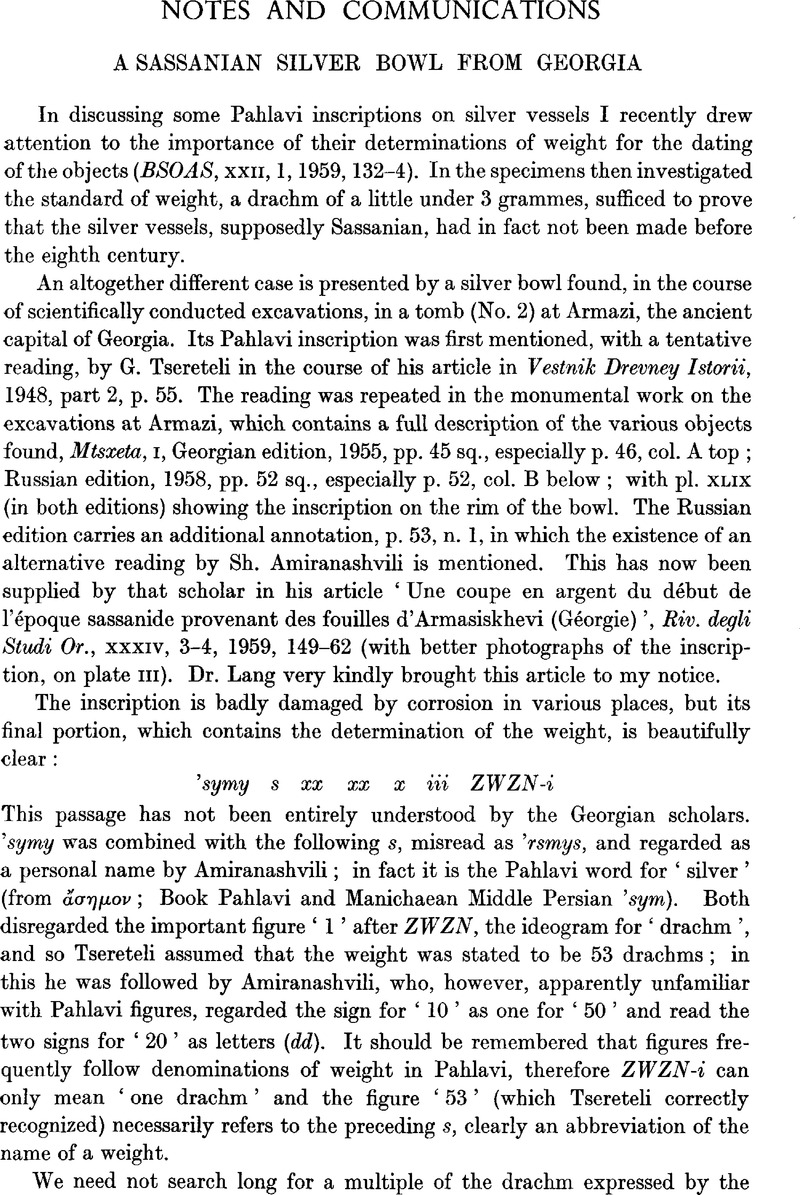Published online by Cambridge University Press: 24 December 2009

page 354 note 2 The value of the drachm, therefore, must have been significantly below ![]() = 4·009 grm. (a difference of 18 thousandths of a gramme); provided, of course, that the weight of the bowl has not been materially altered by corrosion, etc.
= 4·009 grm. (a difference of 18 thousandths of a gramme); provided, of course, that the weight of the bowl has not been materially altered by corrosion, etc.
page 354 note 3 The ideal word here would be npy.
page 354 note 4 It seems to me impossible that a Persian official should not have added MLK'n MLK' after the king's name in an inscription of this type.
page 354 note 5 Which have induced Amiranashvili to read an additional letter (R-) before the next word and (R-btḥšy) regard it as a preposition, a usage unknown to Pahlavi.
page 355 note 1 Also referred to Shāpūr Pahl. 34 (under Shāpūr), before his succession to the dignity of bitax‘Artaxšaθr, the son of the bitaxš (btḥskn)’.
page 355 note 2 His Parthian name indicates that he belonged to the Arsacid line previously ruling in Georgia.
page 355 note 3 An exception is Kltslwby Z Y btḥšy (Shāpūr Pahl. 33), mentioned among the lesser dignitaries. He cannot well have been the bitaxš of Iberia, because under Shāpūr that official was šḥpwḥry ZY biḥšy (who, as is always the case with the Viceroy of Iberia, is named among the highest officials, immediately after the princes of the royal blood); even here no country is mentioned.
page 355 note 4 That Grzn (a form inappropriate to the third century) cannot be read is shown by comparing -zn in ZWZN.
page 355 note 5 If merely the bottom of the letter -l- was preserved.
page 355 note 6 Only a re-examination of the object can show whether there was a word before the owner's name. From one of the photographs (Mtsxeta, I, pi. XLIX, no. 3) one gains the impression that it was preceded by t'šty (?), which would be the appropriate word for ‘bowl’. It occurs on a similar bowl mentioned by Kokovtsov, P. K., Materialï po Arxeologii Rossii, XXXVII, 1918, 82Google Scholar, tašti Athromithr (= *t'šty 'trwmtr ?). I owe my acquaintance with Kokovtsov's note to Dr. Bivar.
page 356 note 1 Who recognized that this Pāpak was the one named in the inscription of Paikuli (of about A.D. 293). He was one of Narseh's principal supporters.
page 355 note 2 Mtsxeta, I, Russian, ed., p. 51 BGoogle Scholar .